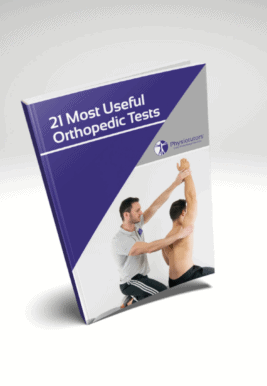Learn
Slump Test Sizer | Neurodynamic Differential Diagnosis
In this post, you will learn how you can use different build-ups of the Slump Test to distinguish between primary disc-related disorders and different secondary disc-related disorders.
The Slump test is a very provocative dural test that poses maximal stress on the dura. If you suspect a severe disc prolapse or extrusion with radicular pain, we do not recommend performing it, as excessive lumbar flexion puts additional stress on the discus and symptoms can usually already be provoked sufficiently with a straight leg raise test according to Lasegue or by simply asking your patient to perform forward flexion of the trunk in standing with straight knees.
In less severe protrusions, epidural adhesions and nerve root compression, or intermittent neurogenic claudication, different build-ups of the slump can help you to distinguish the different disorders.
Let´s look at what those different build-ups can look like. For both initiations, the starting position will be with an erect spine, knees flexed to 90°, and legs hanging off of the table.
Distal Initiation
For the distal initiation, first passively dorsiflex the ankle to distally pre-tension the sciatic nervous tissue distal to the popliteal anchor point.
Then you are going to passively extend the knee, while you fixate the extension with your own knee. This knee extension is going to move the dura distal and lateral with respect to the surrounding container.
Then, the patient tucks his chin in, forward flexes the neck, and slumps the trunk. This position is creating maximal tension on the dura.
At last, release the dorsiflexion, which will allow the dural structures to move back to their starting position.
Proximal Initiation
Like what you’re learning?
BUY THE FULL PHYSIOTUTORS ASSESSMENT BOOK
- 600+ Pages e-Book
- Interactive Content (Direct Video Demonstration, PubMed articles)
- Statistical Values for all Special Tests from the latest research
- Available in 🇬🇧 🇩🇪 🇫🇷 🇪🇸 🇮🇹 🇵🇹 🇹🇷
- And much more!



 Now, let´s look at how to interpret the outcomes. In the case of a primary disc-related disorder like a protrusion, the more the dura is tensioned independent of the direction, the more pain will be provoked. So we will have moderate pain in distal initiation during the ankle dorsiflexion and knee extension, maximal pain with the added chin tuck and neck flexion and pain will be eased with neck and head extension. In the proximal initiation, we will generate mild pain during head, neck, and trunk flexion, the pain will be maximal with added dorsiflexion and straight leg raise, and pain will decrease when the head and neck are extended again. In the case of dural sleeve adhesions, the pain will be provoked when the dura is moved distally because fibrotic adhesions impair dural sleeve mobility in distal direction. So we will have moderate pain with the distal initiation with dorsiflexion + knee extension, decreased pain when we add the chin tuck, neck flexion, and trunk slump, as the dural sleeve is moved cranially again and no pain anymore when dorsiflexion is released. In the proximal initiation, we will have no pain during the chin tuck, head and trunk flexion, and even dorsiflexion and knee extension, because the dura has been pre-tensioned proximally. Only when the neck and head are extended, pain is increased, as the dura moves distally.
Now, let´s look at how to interpret the outcomes. In the case of a primary disc-related disorder like a protrusion, the more the dura is tensioned independent of the direction, the more pain will be provoked. So we will have moderate pain in distal initiation during the ankle dorsiflexion and knee extension, maximal pain with the added chin tuck and neck flexion and pain will be eased with neck and head extension. In the proximal initiation, we will generate mild pain during head, neck, and trunk flexion, the pain will be maximal with added dorsiflexion and straight leg raise, and pain will decrease when the head and neck are extended again. In the case of dural sleeve adhesions, the pain will be provoked when the dura is moved distally because fibrotic adhesions impair dural sleeve mobility in distal direction. So we will have moderate pain with the distal initiation with dorsiflexion + knee extension, decreased pain when we add the chin tuck, neck flexion, and trunk slump, as the dural sleeve is moved cranially again and no pain anymore when dorsiflexion is released. In the proximal initiation, we will have no pain during the chin tuck, head and trunk flexion, and even dorsiflexion and knee extension, because the dura has been pre-tensioned proximally. Only when the neck and head are extended, pain is increased, as the dura moves distally.





